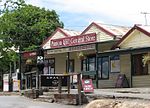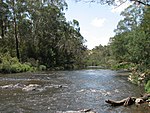Kangaroo Ground War Memorial Park is located at 385 Eltham Yarra Glen Road, Kangaroo Ground in the Shire of Nillumbik. in Victoria, Australia. The site includes the war memorial, with a firespotting cabin, mature monterey cypress trees and other planted species, and a sandstone caretaker's cottage. The park is situated on the summit of Garden Hill, from which panoramic views are obtainable. The park is situated on two acres.Towards the end of World War One, in August 1918, Eltham Shire Council discussed and 'generally expressed themselves as favourable to the proposal' to obtain a "piece of land on the summit of Garden Hill, Kangaroo Ground, and the formation of a memorial park in which a monument could be erected to represent the whole of the Shire. Local resident Walter Wippell donated £50 and with it Council purchased the one-acre site. In 1919 Joseph Mess agreed to take £50 per acre for two acres of his Garden Hill property. By 1920 subscriptions lists were opened for the purposes of raising funds to "carry out the proposed scheme of beautification, and also to erect, at a later date, a fitting monument to perpetuate the memory of those who fell in the Great War'. Working bees took place on the site and rocks were collected for a memorial cairn which was built in a slight depression which signified the highest point in the park. The compilation of "a complete record of the names of all persons who enlised for service from the Shire and of those who made the supreme sacrifice whilst doing their duty" began in 1920. The park was officially opened by Mr. W. H. Everard, M.L.A. on 3 September 1921. In 1927 a stone hut, known as the caretaker's cottage was built from left over stone quarried for the tower. On Remembrance Day, 2005 a seedling, a descendant of the Gallipoli lone pine tree was planted. Brick toilets constructed in 1965 were also removed and replaced in 2005 including a universal access space.In 2006, a plaque was put in place from the Vietnam Veterans community in commemoration of the 40th anniversary of the Battle of Long Tan. Nillumbik Shire Council received funding under the 2008–09 Restoring Community War Memorials Grants program to restore plaques on the Tower, and replace bollards to enhance security around the memorial. In December 2014, Nillumbik Shire Council received Anzac Centenary Local Grants Program funding to create new interpretative signage.In 2015 Shire of Nillumbik added the Tower of Remembrance and War Memorial Park and Moor-ul Viewing Platform to its draft register of memorials. In 2020 Shire of Nillumbik commenced preparing a master plan to create a long-term vision and plan for the park.







